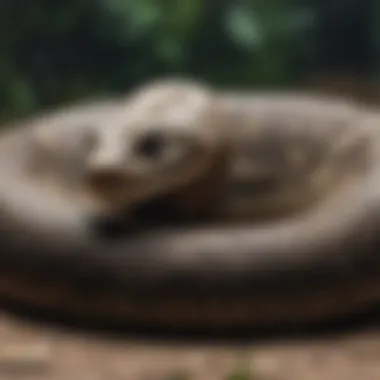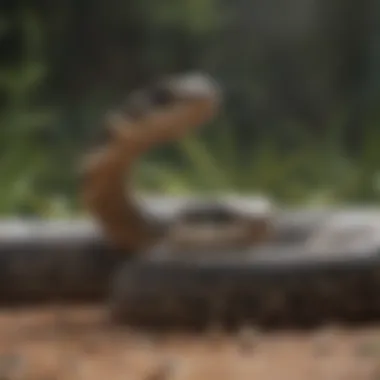Discover the Intriguing Rattlesnake Wonders: Fun Facts for Young Nature Lovers


Nature Topic Overview
Welcome to the fascinating world of rattlesnakes! In this article tailored for young nature enthusiasts, we will delve into the intriguing lives of these remarkable reptiles, exploring their unique behaviors and characteristics with a focus on engaging fun facts.
Fun Facts and Trivia
- Rattlesnakes are known for their distinctive rattle, which is made of loosely attached segments at the end of their tails.
- Did you know that rattlesnakes can live for up to 25 years in the wild?
- Rattlesnakes are pit vipers, possessing specialized heat-sensing pits on their faces to detect prey.
- Some species of rattlesnakes exhibit unique behaviors, such as hunting cooperatively with other snakes.
Wildlife Explorations
Let's explore the diverse species of rattlesnakes that inhabit various habitats across North and South America. From the Western Diamondback to the Eastern Massasauga, each species has adapted distinct characteristics based on their environment. Discover how these reptiles interact with other animals and plants in their ecosystems.
Environmental Awareness
Conservation and sustainability play a crucial role in preserving rattlesnakes and their habitats. Children can contribute to protecting these fascinating creatures by learning about the importance of maintaining a balanced ecosystem and supporting initiatives aimed at wildlife conservation. Encourage young nature enthusiasts to appreciate the role rattlesnakes play in their ecosystems.
DIY Nature Activities
Engage in hands-on activities to deepen your understanding of rattlesnakes. Try creating a model of a rattlesnake's rattle using everyday materials, or embark on a nature walk to observe the habitats where these snakes live. Encourage curiosity and exploration with guided activities that promote a greater appreciation for the natural world.
Introduction to Rattlesnakes
Rattlesnakes are a crucial subject of study, especially when delving into the realm of biodiversity and wildlife. Understanding these fascinating creatures provides a gateway to comprehending the complex ecosystems they inhabit. A comprehensive discussion on Rattlesnakes in this article aims to offer young nature lovers an insight into the intriguing world of reptiles, fostering a sense of appreciation for the natural world. By grasping the basics of Rattlesnakes, readers can develop a deeper understanding of these unique creatures and their importance in the environment.
Basic Information
Description of Rattlesnakes
When exploring the Description of Rattlesnakes, a key focus lies in dissecting the physical attributes and behavioral patterns that define these snakes. Understanding the unique characteristics of Rattlesnakes, such as their distinctive rattle, venomous fangs, and heat-sensing pits, allows for a more profound exploration of their role in the ecosystem. The Description of Rattlesnakes serves as a crucial foundation for comprehending their hunting techniques, communication methods, and survival strategies, making it a pivotal component of this article.
Classification of Rattlesnakes


The Classification of Rattlesnakes provides a systematic framework for categorizing these fascinating creatures based on their anatomical features, habitat preferences, and geographical distribution. By studying the various species and subspecies of Rattlesnakes, readers can delve into the diverse world of reptilian taxonomy, gaining insights into the evolutionary adaptations and ecological niches of these serpents. Understanding the Classification of Rattlesnakes enhances our appreciation for the intricate web of biodiversity present in nature, making it a valuable exploration within this article.
Habitat and Distribution
Diverse Habitats
Exploring the Diverse Habitats of Rattlesnakes reveals the adaptability of these creatures to a wide range of environments, including deserts, grasslands, forests, and wetlands. By examining how Rattlesnakes have evolved to thrive in different ecological settings, readers can grasp the diverse roles they play in maintaining ecosystem balance. The discussion on Diverse Habitats highlights the intricate relationship between Rattlesnakes and their surroundings, shedding light on the importance of preserving diverse habitats for wildlife conservation.
Global Distribution
The Global Distribution of Rattlesnakes unveils the widespread presence of these serpents across various continents, from North America to South America, Asia, and Africa. By mapping out the global range of Rattlesnakes, readers can appreciate the adaptability and resilience of these reptiles in colonizing diverse landscapes. Understanding the Global Distribution of Rattlesnakes offers young nature enthusiasts a glimpse into the interconnectedness of ecosystems worldwide, showcasing the universal significance of biodiversity conservation.
Physical Characteristics
Distinct Features
Examining the Distinct Features of Rattlesnakes unveils a plethora of unique traits that set them apart from other snake species. From their heat-sensitive pits that detect prey to their hollow rattles used for communication, Rattlesnakes showcase a remarkable array of adaptations honed through evolution. By dissecting the Distinct Features of Rattlesnakes, readers can marvel at the intricate biological mechanisms that enable these serpents to thrive in their respective environments, providing a captivating narrative within this article.
Color Variations
The Color Variations exhibited by Rattlesnakes offer a visual feast of diverse patterns and hues, ranging from earthy browns and muted greys to vibrant yellows and striking blacks. Each color variation serves a specific purpose, be it camouflaging in their surroundings, warning off predators, or attracting potential mates. By unraveling the secrets behind Rattlesnakes' coloration, readers can appreciate the aesthetic beauty and functional adaptations that underline the survival strategies of these elusive reptiles, enriching their understanding of snake biology.
Behavioral Insights
In this section, we delve into the fascinating world of rattlesnakes' behaviors and the importance of understanding them. By observing their behavior, we can gain valuable insights into how these reptiles navigate their environments, hunt for prey, and protect themselves. Exploring the behavioral aspects of rattlesnakes provides a deeper understanding of their survival strategies and interactions with their surroundings, shedding light on the complexities of their existence.
Hunting and Feeding Behavior
Ambush Strategies
Rattlesnakes employ a unique hunting technique known as Ambush Strategies. This method involves lying in wait for unsuspecting prey to pass by, relying on stealth and patience to secure their next meal. The key characteristic of Ambush Strategies is the element of surprise, allowing rattlesnakes to conserving energy while maximizing their hunting success rate. This strategy proves beneficial in this article as it showcases the adaptability and intelligence of rattlesnakes in securing food efficiently.
Prey Preferences


Understanding the Prey Preferences of rattlesnakes is essential in decoding their feeding behavior. These reptiles display distinct choices in prey selection, often opting for small mammals, birds, or amphibians. The key characteristic of Prey Preferences lies in the interplay between predator and prey dynamics, influencing the rattlesnakes' hunting patterns. By exploring these preferences, we gain insight into the ecological role of rattlesnakes and their significance in maintaining the ecosystem's balance.
Reproduction and Life Cycle
Mating Rituals
The Mating Rituals of rattlesnakes are a crucial aspect of their life cycle, dictating their reproductive success. These rituals involve intricate behaviors and displays aimed at attracting suitable mates. The key characteristic of Mating Rituals is the precise coordination between male and female rattlesnakes, enhancing the chances of successful reproduction. By examining these rituals, we uncover the complexities of rattlesnakes' social interactions and breeding strategies, offering a glimpse into their evolutionary adaptations.
Birth and Growth Process
Exploring the Birth and Growth Process of rattlesnakes unveils the long journey from birth to maturity. Rattlesnakes undergo distinct growth stages, facing various challenges and threats along the way. The key characteristic of this process is the resilience displayed by young rattlesnakes as they navigate their environment and develop crucial survival skills. By understanding this journey, we gain insight into the vulnerabilities and strengths of rattlesnakes during their formative years.
Defense Mechanisms
Rattling Warning Signal
Rattlesnakes use a unique defense mechanism known as the Rattling Warning Signal to deter potential threats. This signal involves the iconic rattle on their tails, producing a distinctive sound as a cautionary tactic. The key characteristic of this warning signal is its dual purpose of warning predators and signaling their presence to avoid confrontation. This feature proves advantageous in this article as it highlights the adaptive strategies rattlesnakes employ to protect themselves in their habitats.
Venomous Bite
The Venomous Bite of rattlesnakes serves as a potent defense mechanism against predators or threats. This venomous adaptation is a key characteristic that sets rattlesnakes apart in the animal kingdom, providing them with a means of immobilizing prey or defending themselves. By delving into the unique features of the venomous bite, we gain a deeper appreciation for the sophisticated defense mechanisms that have evolved in rattlesnakes, shaping their survival tactics in challenging environments.
Interesting Facts and Myths
In the realm of rattlesnakes, understanding their interesting facts and dispelling prevalent myths is vital for a well-rounded comprehension of these fascinating creatures. By exploring intriguing details and separating fact from fiction, young nature enthusiasts can deepen their appreciation for wildlife.
Fascinating Trivia
Thermal Sensing Abilities
Delving into the thermal sensing abilities of rattlesnakes unveils a remarkable aspect of their physiology. These reptiles possess unique sensory organs known as pit organs, which enable them to detect infrared radiation emitted by warm-blooded prey. This extraordinary adaptation aids rattlesnakes in hunting, even in low-light conditions, showcasing their evolutionary prowess. The ability to sense thermal gradients with precision allows them to locate prey efficiently, exhibiting a specialized adaptation highly advantageous in their ecosystem.


Tail Rattle Evolution
The evolution of the iconic rattlesnake tail rattle serves as a compelling aspect of their behavioral repertoire. This specialized adaptation has transformed over generations to act as a warning mechanism, producing a distinct sound when vibrated. The segments of the rattle, made of keratin, produce a buzzing sound to deter potential threats. Through natural selection, rattlesnakes have developed this unique feature as a defense strategy, showcasing the intricacies of evolutionary processes in response to environmental pressures.
Common Misconceptions
Unraveling common misconceptions surrounding rattlesnakes is crucial in fostering accurate knowledge and dispelling unfounded fears. By addressing prevalent misconceptions, readers can gain a more nuanced understanding of these reptiles, promoting coexistence and conservation efforts.
Harmless Snake Lookalikes
Examining harmless snake species often mistaken for rattlesnakes sheds light on misidentifications in the wild. Understanding the key differences in appearance and behavior between rattlesnakes and non-venomous counterparts enhances safety and prevents unnecessary harm to these harmless snakes. Educating individuals on distinguishing features mitigates unwarranted fear and portrays these lookalikes in their true non-threatening nature.
Mythical Representations
Exploring mythical representations of rattlesnakes in various cultural contexts adds a layer of intrigue to understanding human-animal relationships. Mythology often depicts these creatures in diverse roles, ranging from symbols of danger to guardians of wisdom. By delving into these mythical narratives, readers can appreciate the symbolic significance of rattlesnakes in different cultures, transcending biological facts to embrace the richness of storytelling and symbolism.
Conservation Efforts
Conservation efforts play a crucial role in preserving the delicate balance of ecosystems and protecting the biodiversity of rattlesnakes. By focusing on conservation efforts, we actively work towards safeguarding these fascinating reptiles for future generations. The intricate web of interactions in nature depends on maintaining healthy populations of rattlesnakes, making conservation efforts imperative. Not only do these initiatives benefit rattlesnakes themselves but also contribute to the overall health of the ecosystem they inhabit.
Challenges and Threats
Habitat Loss
Habitat loss poses a significant threat to rattlesnakes' survival. The destruction of their natural habitats due to human activities such as urbanization and deforestation leads to a decline in the available space for rattlesnakes to thrive. This loss of habitat not only diminishes the population of rattlesnakes but also disrupts the balance of the ecosystem they are a part of. Understanding the key characteristics of habitat loss is essential to address this pressing issue effectively.
Illegal Wildlife Trade
Illegal wildlife trade further exacerbates the challenges faced by rattlesnakes. The illicit market for exotic pets and wildlife products drives the poaching of rattlesnakes for commercial gains. Engaging in the illegal wildlife trade not only disrupts rattlesnake populations but also poses a threat to their survival in the wild. Uncovering the key characteristics of this trade sheds light on the dark reality of how human activities impact these unique reptiles.
Conservation Initiatives
Protective Legislations
Protective legislations serve as a vital tool in safeguarding rattlesnakes from various threats. These legal measures establish guidelines for habitat protection, anti-poaching efforts, and conservation practices to ensure the well-being of rattlesnakes. Implementing protective legislations underscores the importance of preserving the natural habitats of rattlesnakes and curbing illegal activities that endanger their existence.
Research and Awareness Programs
Research and awareness programs contribute significantly to the conservation of rattlesnakes. Through scientific studies and educational campaigns, these initiatives enhance our understanding of rattlesnakes' behaviors, habitats, and conservation needs. By raising awareness about the importance of rattlesnake conservation, these programs empower individuals to take proactive steps towards protecting these remarkable reptiles.







